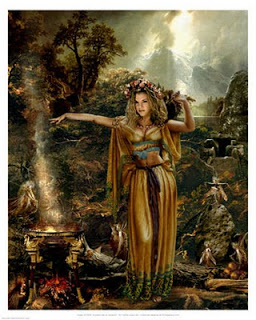
In Irish and Scottish Folklore, the Aos Si(also called:Aes Sidhe (an older form of the word)
anddaoine sídhe)are a category of supernatural beings and spirits that are said to walk among the living. Much like the more commonly knownFaery, they come in a variety of types with varying behaviors. Aos Si literally translates to, “People of the Mounds,” which acts as testament to their dwelling beneath the earth, or inFairyMounds(Also called, “ The Sidhe,” which means, "Mounds" ). Some have stated that they are also known to make their home in the western sea, and more extraordinarily, in an invisible world that coexists with our own, but remains separated by a veil of some sort, this could mean that they are literallyotherworldlybeings. Because of this, on top of being thought of as spirits, some believe them to be theAncestors, Spirits of the natural world, or even Gods and Goddesses.
As stated above, the Aos Si come in a variety of forms, so describing their appearance based on a single depiction wouldn't quite do them justice. With that in mind, they are said to appear as beautiful men and women, looking somewhat
Faeor elven in their depiction, this applies to the likes of the Bean Sith (See:
Banshee) and Leannan Sidhe . However, this does not apply to all of the Aos Si, for some can appear either as more animalistic creatures, like the Cu Sith/Sidhe and Cait Sith/Sidhe, or as frightful monsters or spirits, like the Banshee (again), Fachen, and
Dullahan.
Interestingly enough, in many Gaelic cultures, they are known as, “The Good Neighbors,” or, “The Folk,” which further associates them with Faery lore. They are both honored and feared among the locals, for they can both be benevolent and malevolent creatures depending on how they're treated.
(Taken from Wikipedia:) “As part of the terms of their surrender to the Milesians the Tuatha Dé Danann agreed to retreat and dwell underground in the sídhe (modern Irish: sí; Scottish Gaelic: sìth; Old Irish síde, singular síd), the hills or earthen mounds that dot the Irish landscape. In some later poetry each tribe of the Tuatha Dé Danann was given its own mound.
In a number of later English language texts the word sídhe is used both for the mounds and the people of the mounds. However sidh in older texts refers specifically to "the palaces, courts, halls or residences" of the ghostly beings that, according to Gaedhelic mythology, inhabit them.[2]
The fact that many of these sídhe have been found to be ancient burial mounds[citation needed] has contributed to the theory that the aos sí were the pre-Celtic occupants of Ireland. "The Book of Invasions", "The Annals of the Four Masters", and oral history support this view.
Others present these stories as mythology deriving from Greek cultural influence, deriving arguments mainly from Hesiod's "Works and Days", which portrays the basic moral foundation and plantation techniques of the citizens of Greece and describes the races of men, created by the Greek deities. However, these views have been deemed unlikely, and the so-called influence can be reasonably explained by the similar moral foundations stemming from the two cultures' Indo-European background.
The story of the Aes Sídhe is found all over Scotland and Ireland, many tales referring to how the Norse invaders drove Scottish inhabitants underground to live in the hills. This part of the legend contributes to the Changelingmyth in west European folklore.”
Attributes: Various, some being death, others being that of an element.
Type of Creature:
Fae and Spirits
Behavior: Varied, they come in all kinds.
Various kinds of Aos Si:
Banshee, Cat/Cait Sith/Sidhe, Cu Sith/Sidhe, Bean Nigh (See: Washer Woman),
Clurichaun, Puca/Pwca, Leannan Sith,
Leprechaun, Fachen, Dullahan, Fear Dearg, and more.
